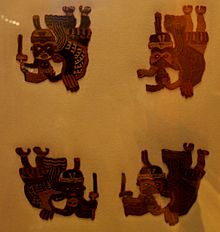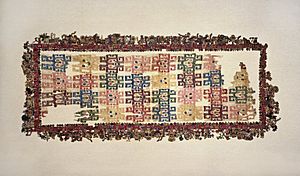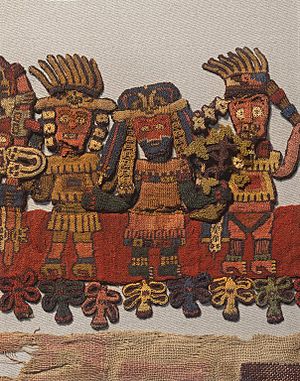Paracas textile facts for kids
Quick facts for kids Paracas textile |
|
|---|---|
 |
|
| Material | Wool and cotton |
| Created | 300–200 BCE |
| Discovered | Peru |
| Present location | British Museum, London |
The Paracas textiles are amazing ancient cloths found in Peru. They were discovered in the 1920s at a special burial site called a necropolis. This site held 420 bodies that had been mummified. Each body was carefully wrapped in these beautiful, embroidered textiles. These cloths were made by the Paracas culture around 300 to 200 BCE.
Contents
What Are Paracas Textiles?
These incredible textiles were made by people in South America over a thousand years before the famous Inca civilization. They are very brightly colored and show detailed designs. The pictures on the textiles often show special figures or spiritual leaders. These figures might be holding symbolic objects or have wings, like birds. Some people think these images show spirits carrying people to the next world. Others believe the figures themselves are spirits.
The people who made these textiles had a very advanced society. They were skilled at many things, like making pottery, fishing, and farming. They also had talented craftspeople. These artists could make sharp knives from obsidian rock and beautiful jewelry from gold. They also understood the complex art of weaving these amazing textiles.
How Were They Made?
The Paracas textiles were made from wool and cotton. The wool likely came from animals like alpacas or llamas. What's really special is that the natural dyes used to color the textiles have kept their bright colors for over 2,000 years! This is unusual because colors usually fade over time. The dry conditions where they were buried, along with being protected from sunlight, helped preserve their vibrant look.
The smaller pieces of textile you see in museums today were once part of much larger cloths. These big cloths were used to wrap the mummified bodies. Some of these wrapping cloths were as long as 100 feet (about 34 meters)! Imagine how many people and how much effort it took to create such huge and detailed textiles. The bodies were often found in groups, like family burial places used by many generations.
Some of the skulls found with the textiles were quite unusual. Many had been reshaped in strange ways. This was done by attaching boards or weights to a baby's head as it grew. Other skulls showed signs of trepanning. This was an ancient surgery where holes were drilled into the skulls of living people. Amazingly, many of these holes had healed, showing that the patients survived this process! Museums in Peru, like the Museo Regional de Ica, display both these unique skulls and the textiles found with them.
Where Were They Found?
The ancient burial site, or necropolis, was discovered on the Paracas Peninsula by a famous archaeologist named Julio C. Tello in the 1920s. Tello first visited the area in 1925, following clues from ancient textiles he had bought earlier. In 1927, Tello and his team found the first of many ceremonial mummy bundles. They discovered bodies sitting in baskets, each wrapped in large, beautifully embroidered textiles.
A special museum was built near Paracas to house these incredible finds. This was requested by President Benevides in 1938. Tello and his team worked hard to preserve 380 textiles, and they were able to display over 180 of them.
The embroidered pieces you might see in places like the British Museum are fragments from larger cloths. These pieces were removed before the British Museum bought them. Today, these ancient textiles are kept in special conditions, often in dim light, to protect them from damage.
A World-Famous Find
These Paracas textile pieces from the British Museum were chosen to be part of A History of the World in 100 Objects. This was a series of radio programs that started in 2010. It was a partnership between the BBC and the British Museum, highlighting important objects from history.
See also
 In Spanish: Tejido de Paracas para niños
In Spanish: Tejido de Paracas para niños




